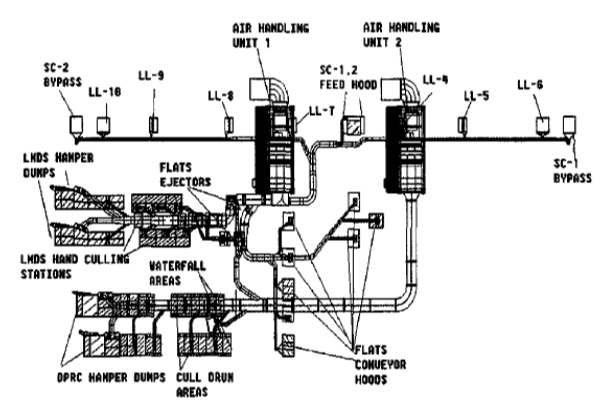Engineering Controls Database
U.S. Postal Service Contaminant Controls – Loose Mail Distribution System & Dual Pass Rough Cull of the 010 Culling System
|
In 2001, terrorist attacks took place where anthrax spores were sent by mail to a U.S. Senator and to media offices [CDC 2001]. These attacks resulted in exposure to anthrax spores by postal employees working in a mail processing facility that serves the U.S. Capitol and resulted in inhalation disease in several of the workers [Mayer et al. 2001]. One potential area of exposure in the United States Postal Service (USPS) is the automated mail processing equipment used to sort incoming mail. As the mail passes through the machinery, it is compressed and impacted in a number of places that could cause release of substances from the mail. |
|
| Bacillus anthracis is a large spore forming bacteria. In the vegetative state, it is rod shaped and ranges in size from 1-1.5 X 3-10 µm. The anthrax spores are typically in the 1-5 µm size range and can enter the body by being inhaled, through the skin, or through ingestion. Disease occurs when spores enter the body, germinate, and multiply. The cutaneous form of the disease generally develops 2-5 days following exposure and can usually be successfully treated with antibiotics. The onset for the inhalation form is typically l-6 days after exposure. The inhalation form generally has a high fatality rate even with appropriate treatment [Pile et al. 1998]. | |
|
Researchers from the National Institute for Occupational Safety and Health (NIOSH) were requested to assist the USPS in the evaluation of particulate controls for various mail processing equipment. These new controls are being installed to reduce operator exposure to any potentially hazardous contaminants emitted from letter mail during normal mail processing. This effort is driven by the terrorist attacks which used the mail as a delivery system for anthrax. There were a number of reports generated by NIOSH that evaluated controls put in place by the USPS to control release of contaminants into work areas of postal employees. This summary describes a report on the Loose Mail Distribution System (LMDS) and the Dual Pass Rough Cull (DPRC). The controls were designed and installed by a USPS contractor and were intended to significantly reduce the potential for operator exposure to bacterial contaminants that could be contained in the mail pieces processed by the equipment. The USPS 010 Culling System is comprised of two conveyer systems that size the collection mail brought to a processing and distribution center into letters, flats, and parcels. The first system is the DPRC and the second is the LMDS. Flats and parcels are separated from the letter mail and sent to the appropriate areas of the facility for processing. The output of the LMDS sends letter mail to the next stage in its processing which is the cancellation equipment. At the time this evaluation was conducted, the Ventilation/Filtration System (VFS) for the 010 Culling System consisted of two separate air-handling/filtration units that provided exhaust for various locations of possible contamination release. Air-handling Unit # 1 processed about 18,176 cubic feet per minute (cfm) which represented dirty filter conditions for the VFS. Air-handling Unit # 2 processed about the same flow rate and served the primary areas of the DPRC. Each of the air-handling units was fitted with three stages of filtration composed of a pre-filter, a MERV 14 filter and a High Efficiency Particulate Air (HEPA) filter (Figure 1).  |
|
| 279-21A; | |
|
CDC (Centers for Disease Control and Prevention) [2001]. Investigation of bioterrorism-related anthrax and interim guidelines for exposure management and antimicrobial therapy. MMWR 50:909-919. Mayer TA, Bersoff-Matcha S, Murphy C, Earls J, Harper S, Pauze D, Nguyen M, Rosentahal J, Cerva D, Druckenbrod G, Hanfling D, Fatteh N, Napoli A, Nayyar A, Berman EL [2001]. Clinical presentation of inhalation anthrax following bioterrorism exposure. JAMA 286(20): 2549-2553. Pile JC, Malone JD, Eitzen EM, Friedlander AM [1998]. Anthrax as a potential biological warfare agent. Arch Intern Med 158:429-434. |
|
| 333318 | |
|
anthrax anthrax dual pass rough cull dual pass rough cull engineering control engineering control loose mail distribution system loose mail distribution system mail handlers mail handlers United States Postal Service United States Postal Service |
|
| Evaluations were based on a variety of tests including tracer gas experiments, air velocity measurements and smoke release observations. The ventilation system met or exceeded overall expectations for the tracer gas experiments (above 98% capture efficiency) and for smoke release observations (excellent capture at all points). These results can be explained by the large air volume that is moved into the VFS in this area. At the DPRC system some smoke did escape when released against the flow on the conveyor belt. However, when sampled with test mail, the smoke was pulled into the VFS with no noticeable complications. The air velocity measurements were consistently above 150 fpm (goal for UPSP capture velocity) at all points, even when tested with a 25% flow reduction of regular flow characteristics. |
